Solar eclipse of August 21, 2017: Difference between revisions
Reverted good faith edits by 2600:1005:B12E:2596:D466:AAC4:33C:2CB3 (talk): Bad way to show a source. (TW) |
No edit summary Tag: references removed |
||
| Line 1: | Line 1: | ||
| ⚫ | |||
{{Infobox solar eclipse|2017Aug21}} |
|||
| ⚫ | | te = Ju pse occurs when the [[Moon]] passes between [[Earth]] and the [[Sun]], thereby totally or partly obscuring the image of the Sun for a viewer on Earth. A total solar eclipse occurs when the Moon's [[apparent diameter]] is larger than the Sun's, blo partial solar eclipse visible over a surrounding region thousands of kilometers wide. |
||
A [[solar eclipse#Types|total solar eclipse]] will occur on Monday, August 21, 2017. It will be visible in totality only within a band across the entire [[contiguous United States]].<ref name=aspcs>{{Cite journal |
|||
| author = Fraknoi, A. |
|||
| author2 = Schatz, D.; Shore, L. |
|||
| year = 2015 |
|||
| ⚫ | |||
| journal = [[Astronomical Society of the Pacific Conference Series]] |
|||
| volume = 500, Celebrating Science: Putting Education Best Practices to Work |
|||
| page = 55 |
|||
| url = http://aspbooks.org/publications/500/055.pdf |
|||
| access-date = July 3, 2017 |
|||
}}</ref> The previous time a total solar eclipse was visible across the entire contiguous United States was during the [[Solar eclipse of June 8, 1918|June 8, 1918 eclipse]]. |
|||
| ⚫ | |||
This eclipse is the 22nd of the 77 members of [[Solar Saros 145|Saros series 145]], which also produced the [[solar eclipse of August 11, 1999]]. Members of this series are increasing in duration. The longest eclipse in this series will occur on June 25, 2522 and last for 7 minutes and 12 seconds. |
This eclipse is the 22nd of the 77 members of [[Solar Saros 145|Saros series 145]], which also produced the [[solar eclipse of August 11, 1999]]. Members of this series are increasing in duration. The longest eclipse in this series will occur on June 25, 2522 and last for 7 minutes and 12 seconds. |
||
Revision as of 14:25, 27 July 2017
clipse of 2017: An Outreach Opportunity and Challenge | te = Ju pse occurs when the Moon passes between Earth and the Sun, thereby totally or partly obscuring the image of the Sun for a viewer on Earth. A total solar eclipse occurs when the Moon's apparent diameter is larger than the Sun's, blo partial solar eclipse visible over a surrounding region thousands of kilometers wide.
This eclipse is the 22nd of the 77 members of Saros series 145, which also produced the solar eclipse of August 11, 1999. Members of this series are increasing in duration. The longest eclipse in this series will occur on June 25, 2522 and last for 7 minutes and 12 seconds.
Visibility
The total eclipse will have a magnitude of 1.0306 and will be visible from a narrow corridor through the United States. It will be first seen from land in the US shortly after 10:15 a.m. PDT at Oregon's Pacific coast, and then it will progress eastward through Salem, OR, Casper, WY, Lincoln, NE, Kansas City, Nashville, TN, Columbia, SC, and finally Charleston, SC. A partial eclipse will be seen for a greater time period, beginning shortly after 9:00 a.m. PDT along the Pacific Coast of Oregon.
The longest duration of totality will be 2 minutes 41.6 seconds at about 37°35′0″N 89°7′0″W / 37.58333°N 89.11667°W in Giant City State Park, just south of Carbondale, Illinois, and the greatest extent (width) will be at 36°58′0″N 87°40′18″W / 36.96667°N 87.67167°W near the village of Cerulean, Kentucky, located in between Hopkinsville, KY and Princeton, KY.[1][2] This will be the first total solar eclipse visible from the Southeastern United States since the solar eclipse of March 7, 1970, which was only visible from Florida.
A partial solar eclipse will be seen from the much broader path of the Moon's penumbra, including all of North America, northern South America, Western Europe, and some of Africa.
Related eclipses over the United States

This eclipse will be the first total solar eclipse visible from the United States since the solar eclipse of July 11, 1991[3] (which was seen only from part of Hawaii),[4] and the first visible from the contiguous United States since 1979.[5]
The path of totality of the solar eclipse of February 26, 1979 passed only through the states of Washington, Oregon, Idaho, Montana, and North Dakota. Many visitors traveled to the Pacific Northwest to view the eclipse, since it was the last chance to view a total solar eclipse in the contiguous United States for almost four decades.[6][7]
Some American scientists and interested amateurs seeking to experience a total eclipse participated in a four-day Atlantic Ocean cruise to view the solar eclipse of July 10, 1972 as it passed near Nova Scotia. Organizers of the cruise advertised in astronomical journals and in planetarium announcements emphasizing the lack of future U.S. total eclipses until this 2017 event.[8]
The August 2017 eclipse will be the first with a path of totality crossing the US's Pacific coast and Atlantic coast since 1918. Also, its path of totality makes landfall exclusively within the United States, making it the first such eclipse since the country's independence in 1776. (The path of totality of the eclipse of June 13, 1257, was the last to make landfall exclusively on lands currently part of the US.[9])
The path of this eclipse crosses the path of the upcoming total solar eclipse of April 8, 2024, with the intersection of the two paths being in southern Illinois in Makanda Township at Cedar Lake just south of Carbondale. A small land area, including the cities of Makanda, Carbondale, Cape Girardeau, Missouri, and Paducah, Kentucky, will thus experience two total solar eclipses within a span of fewer than seven years.
The solar eclipse of August 12, 2045 will have a very similar path of totality over the US, about 400 km (250 mi) to the southwest, also crossing the US's Pacific coast and Atlantic coast; however, duration of totality will last over twice as long.[10]
An eclipse of comparable length (up to 3 minutes 8 seconds) occurred over the contiguous United States on March 7, 1970 along the southeast US coast, from Florida to Virginia.[11]
Total eclipse viewing events
Oregon
- Corvallis, Oregon - The Corvallis campus of Oregon State University will host OSU150 Space Grant Festival: A Total Eclipse Experience a weekend-long celebration of the eclipse featuring hands-on activities, informative talks, interactive exhibits, an outdoor evening movie, music, food vendors and more. A watch party will also be hosted on campus the day of the eclipse.
- Madras, Oregon – The city will sponsor a four-day Solarfest at two locations.[12][13]
- Prineville, Oregon – Symbiosis Gathering will be hosting a global eclipse gathering.[14] Dubbed Oregon Eclipse,[15] the event will feature music, workshops, and art.
- Salem, Oregon – The Oregon Museum of Science and Industry will host an event at the Oregon State Fairgrounds.[16]
Idaho
- Rexburg, Idaho – Brigham Young University Idaho will offer a series of eclipse related educational events.[17]
Wyoming
- Casper, Wyoming – The Astronomical League, an alliance of amateur astronomy clubs, will hold its annual Astrocon conference,[18] and there will be other public events, called Wyoming Eclipse Festival 2017.[19]
Nebraska
- Alliance, Nebraska – Entertainment and educational seminars will be offered.[20]
- Grand Island, Nebraska – The Stuhr Museum will host an eclipse viewing event, including the launch of a NASA eclipse observing balloon.[21]
Missouri
- Lathrop, Missouri – The city will celebrate its 150th anniversary with an eclipse festival.[22]
- Parkville, Missouri – #TotalEclipseofthePark: An August 20 educational program featuring NASA Glenn Research Center Hall of Famer Lynn Bondurant, '61, and August 21 watch party organized by Park University.[23]
- St. Clair, Missouri – An event organized by the St. Clair City Chamber of Commerce.[24]
- St. Joseph, Missouri – An event organized by Front Page Science will be held at Rosecrans Memorial Airport.[25]
Illinois
- Carbondale, Illinois – The area is calling itself the Eclipse Crossroads of America since it will also be in totality during the Solar eclipse of April 8, 2024, and since Giant City State Park, just south of the city, will experience the longest period of totality during the eclipse (approximately 2 minutes and 40 seconds). Southern Illinois University will sponsor many eclipse related educational events, including the two day Crossroads Astronomy, Science and Technology Expo, and viewing at Saluki Stadium.[26]
- Carterville, Illinois – A three-day rock festival called Moonstock will be headlined by Ozzy Osbourne, who will perform during the eclipse.[27]
- Goreville, Illinois – View the eclipse with the University of Illinois Astronomy Department.[28]
Kentucky
- Bowling Green, Kentucky — Western Kentucky University will host 15,000 K-12 students in its football stadium.[29]
- Hopkinsville, Kentucky – A four-day eclipse festival will be held at Jefferson Davis State Historic Site.[30]
Tennessee
- Clarksville, Tennessee – Austin Peay State University will present several educational events, including an appearance by astronaut Rhea Seddon.[31]
- Cookeville, Tennessee – Tennessee Technological University will be hosting a solar eclipse viewing party at Tucker Stadium, which is open to the public. The city of Cookeville will be hosting special events Saturday-Monday.[32]
- Nashville, Tennessee – The largest city in the path of totality is offering many special events, including the Music City Eclipse Science & Technology Festival at the Adventure Science Center.[33]
North Carolina
- Bryson City, North Carolina – Planetarium shows will be offered, as well as rides on the Great Smoky Mountains Railroad to an eclipse location.[34]
- Rosman, North Carolina - Pisgah Astronomical Research Institute (PARI) will be hosting a viewing event. The event at PARI has garnered international attention and the visitors will include about amateur astronomers.
South Carolina
- Columbia, South Carolina – The South Carolina State Museum will host four days of educational events, including an appearance by Apollo 16 astronaut Charles Duke.[35]
- Greenville, South Carolina – Viewing at Furman University.[36] Events include streaming coverage from NASA, educational activities, and live music.[37]
Viewing from outside the United States
Canada
A partial eclipse will be visible across the width of Canada, ranging from 89% in Victoria, British Columbia to 11% in Resolute, Nunavut.[38]
Central America, Mexico, Caribbean islands
A partial eclipse will be visible from Central America, Mexico, and the Caribbean islands.
Europe

In northwestern Europe, the eclipse will only be visible as a partial eclipse, in the evening or at sunset. Only Iceland, Ireland and Scotland will see the eclipse from beginning to end; in the rest of the UK, Norway, the Netherlands, Belgium, France, Spain and Portugal, sunset will occur before the end of the eclipse. In Germany, the beginning of the eclipse will be potentially visible just at sunset only in the extreme northwest of the country. In all regions east of the orange line in the map, the eclipse will be invisible.[39]
Online Viewing Events
- NASA - Live video streams of the event will be available on NASA's website.[40]
- Exploratorium - A live-stream of the event can be seen in-person at the Exploratorium museum in San Francisco, California or online on their website.[41]
Images
-
Animation
-
Another Animation
-
Umbra (black oval), penumbra (concentric shaded ovals), and path of totality (red).
-
High resolution map of the path in the United States.
-
This video features several visualizations of the event.
Impact
The eclipse will cause a reduction of solar power where the shadow reaches solar panels. The North American Electric Reliability Corporation measures impacts of this event,[42] and predicts minor impacts.[43] In California, solar power may decrease by 6,000 Megawatt at 70 MW/minute, and then ramp up by 90 MW/minute as the shadow passes. CAISO’s typical ramp rate is 29 megawatts per minute.[44] The Solar eclipse of March 20, 2015 caused manageable solar power decreases in Europe;[45] in Germany, solar power dropped from 14 GW to 7 GW, of a 38 GW solar power capacity.[46]
Public recognitions
On June 20, 2017,[47] the United States Postal Service released the first application of thermochromic ink to postage stamps in its Total Eclipse of the Sun Forever stamp[48] to commemorate the solar eclipse of August 21, 2017. When pressed with a finger, body heat turns the black circle in the center of the stamp into an image of the full moon. The stamp image is a photo of a total solar eclipse seen in Jalu, Libya, on March 29, 2006. The photo was taken by retired NASA astrophysicist Fred Espenak.
Related eclipses
A partial lunar eclipse will take place on August 7, 2017. It will be visible over eastern Europe, Africa, Asia and Australia.
Solar eclipses 2015–2018
This eclipse is a member of a semester series. An eclipse in a semester series of solar eclipses repeats approximately every 177 days and 4 hours (a semester) at alternating nodes of the Moon's orbit.[49]
The partial solar eclipse on July 13, 2018 occurs in the next lunar year eclipse set.
| Solar eclipse series sets from 2015 to 2018 | ||||||
|---|---|---|---|---|---|---|
| Descending node | Ascending node | |||||
| Saros | Map | Gamma | Saros | Map | Gamma | |
120 Totality in Longyearbyen, Svalbard |
March 20, 2015 Total |
0.94536 | 125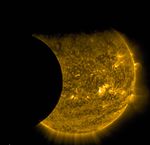 Solar Dynamics Observatory |
September 13, 2015  Partial |
−1.10039 | |
130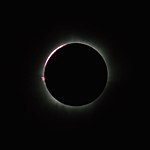 Balikpapan, Indonesia |
March 9, 2016 Total |
0.26092 | 135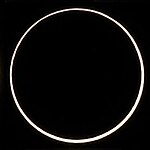 Annularity in L'Étang-Salé, Réunion |
September 1, 2016 Annular |
−0.33301 | |
140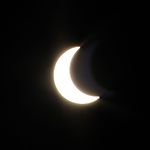 Partial from Buenos Aires, Argentina |
February 26, 2017 Annular |
−0.45780 | 145 Totality in Madras, OR, USA |
August 21, 2017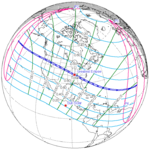 Total |
0.43671 | |
150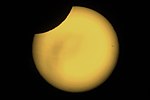 Partial in Olivos, Buenos Aires, Argentina |
February 15, 2018 Partial |
−1.21163 | 155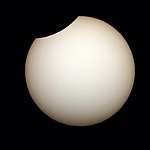 Partial in Huittinen, Finland |
August 11, 2018 Partial |
1.14758 | |
Saros series 145
This eclipse is a part of Saros series 145, repeating every 18 years, 11 days, and containing 77 events. The series started with a partial solar eclipse on January 4, 1639. It contains an annular eclipse on June 6, 1891; a hybrid eclipse on June 17, 1909; and total eclipses from June 29, 1927 through September 9, 2648. The series ends at member 77 as a partial eclipse on April 17, 3009. Its eclipses are tabulated in three columns; every third eclipse in the same column is one exeligmos apart, so they all cast shadows over approximately the same parts of the Earth.
The longest duration of annularity was produced by member 15 at 6 seconds (by default) on June 6, 1891, and the longest duration of totality will be produced by member 50 at 7 minutes, 12 seconds on June 25, 2522. All eclipses in this series occur at the Moon’s ascending node of orbit.[50]
| Series members 10–32 occur between 1801 and 2200: | ||
|---|---|---|
| 10 | 11 | 12 |
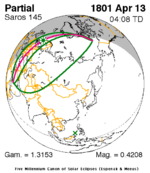 April 13, 1801 |
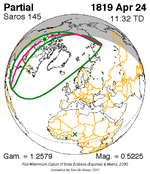 April 24, 1819 |
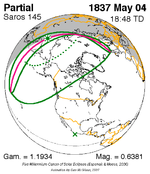 May 4, 1837 |
| 13 | 14 | 15 |
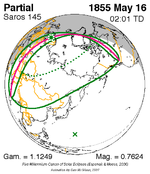 May 16, 1855 |
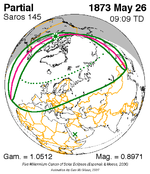 May 26, 1873 |
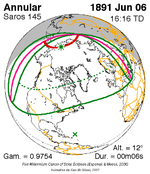 June 6, 1891 |
| 16 | 17 | 18 |
 June 17, 1909 |
 June 29, 1927 |
 July 9, 1945 |
| 19 | 20 | 21 |
 July 20, 1963 |
 July 31, 1981 |
 August 11, 1999 |
| 22 | 23 | 24 |
 August 21, 2017 |
 September 2, 2035 |
 September 12, 2053 |
| 25 | 26 | 27 |
 September 23, 2071 |
 October 4, 2089 |
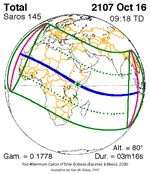 October 16, 2107 |
| 28 | 29 | 30 |
 October 26, 2125 |
 November 7, 2143 |
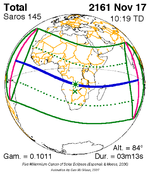 November 17, 2161 |
| 31 | 32 | |
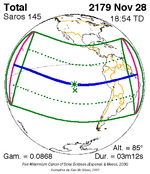 November 28, 2179 |
 December 9, 2197 | |
Metonic series
The metonic series repeats eclipses every 19 years (6939.69 days), lasting about 5 cycles. Eclipses occur in nearly the same calendar date. In addition, the octon subseries repeats 1/5 of that or every 3.8 years (1387.94 days). All eclipses in this table occur at the Moon's ascending node.
| 20 eclipse events between June 10, 1964 and August 21, 2036 | ||||
|---|---|---|---|---|
| June 10–11 | March 28–29 | January 14–16 | November 3 | August 21–22 |
| 117 | 119 | 121 | 123 | 125 |
 June 10, 1964 |
 March 28, 1968 |
 January 16, 1972 |
 November 3, 1975 |
 August 22, 1979 |
| 127 | 129 | 131 | 133 | 135 |
 June 11, 1983 |
 March 29, 1987 |
 January 15, 1991 |
 November 3, 1994 |
 August 22, 1998 |
| 137 | 139 | 141 | 143 | 145 |
 June 10, 2002 |
 March 29, 2006 |
 January 15, 2010 |
 November 3, 2013 |
 August 21, 2017 |
| 147 | 149 | 151 | 153 | 155 |
 June 10, 2021 |
 March 29, 2025 |
 January 14, 2029 |
 November 3, 2032 |
 August 21, 2036 |
References
- ^ "2017 August 21 Total Solar Eclipse". USNO. Retrieved 25 April 2014.
- ^ https://eclipse.gsfc.nasa.gov/SEplot/SEplot2001/SE2017Aug21T.GIF
- ^ "The Great Baja Eclipse", Discover January 1991. p. 90.
- ^ Total and Annular Solar Eclipse Paths 1981–2000
- ^ Total and Annular Solar Eclipse Paths 1961–1980
- ^ "Thousands Go West for a Total Solar Eclipse Tomorrow; Data May Aid Energy Research Partial Eclipse for New York Best Types of Film Image of Sun on Screen", The New York Times February 25, 1979. p. 26.
- ^ Browne, Malcom W. (February 27, 1979). "Total Eclipse of the Sun Darkens Skies in Northwest; Total Eclipse Casts Two Minutes of Darkness in West Temperature Falls Sharply Learned of Weather Peculiarities Data on Plasma Sought". The New York Times. p. C4. Retrieved February 19, 2017.
- ^ Schrag, Philip (July 30, 1972). "Let There Be Darkness, Please; When Mercury Is at Quadrature, the Social Director Is a Lonely Man For Two Extremely Short Minutes Everyone Gaped Into the Sky". The New York Times. p. 15. Retrieved February 19, 2017.
- ^ http://eclipse.gsfc.nasa.gov/SEsearch/SEsearchmap.php?Ecl=12570613
- ^ Google Earth Gallery for Solar and Lunar Eclipses, Xavier M. Jubier, 2011
- ^ Total Solar Eclipse of 1970 Mar 07, Fred Espenak
- ^ Quintana, Pedro (November 4, 2016). "Thousands will flock to Madras to view solar eclipse: City gearing up for space, shuttles next August". KTVZ. Retrieved April 2, 2017.
- ^ "Eclipse chasers blaze trail to Oregon for view of a lifetime". The Seattle Times. 2017-06-23. Retrieved 2017-06-30.
- ^ "Oregon Scores International Collaborative Festival With 'Oregon Eclipse'". Dance Music NW. 2016-11-11. Retrieved 2016-11-13.
- ^ "Oregon Eclipse — A Total Solar Eclipse Gathering 17–23 August, 2017 – Oregon Eclipse 2017Oregon Eclipse 2017". oregoneclipse2017.com. Retrieved 2016-11-13.
- ^ "OMSI Total Solar Eclipse Viewing in Salem, Oregon — August 21, 2017". NASA. Retrieved April 2, 2017.
- ^ "Total Solar Eclipse 2017". Brigham Young University Idaho. Retrieved April 2, 2017.
- ^ "2017Astrocon, Casper, Wyoming". Astronomical League. Retrieved April 3, 2017.
a unique opportunity for professional astronomers to intermingle with knowledgeable amateurs; gathering together to learn from each other and exchange ideas.
- ^ "Wyoming Eclipse Festival 2017". Retrieved April 2, 2017.
- ^ "Eclipse Events: We are planning a party – and YOU are invited!". 2017 Solar Eclipse in Alliance. Retrieved April 2, 2017.
- ^ "Gem of the Prairie Eclipse Event". Stuhr Museum.
- ^ "Total Solar Eclipse/150 Years Festival". Lathrop Eclipse.
April 2, 2017
- ^ "Eclipsing Park University". Park University. Retrieved July 13, 2017.
- ^ Darkening of the Sun Festival
- ^ "St. Joseph Eclipse". Front Page Science. Retrieved April 3, 2017.
- ^ "Southern Illinois: eclipse crossroads of America". Southern Illinois University. May 5, 2016.
- ^ Carley, Sean (March 28, 2017). "Remainder of "Moonstock" eclipse festival lineup announced". Daily Egyptian. Retrieved April 2, 2017.
- ^ "View the Eclipse with University of Illinois Astronomers in Goreville, IL". University of Illinois. Retrieved May 3, 2017.
- ^ [1]
- ^ "A Monumental Solar Eclipse Festival: August 18 – August 21". Solar Eclipse Hopkinsville, KY. Retrieved April 2, 2017.
- ^ "Eclipse: Events". Austin Peay State University. Retrieved April 3, 2017.
- ^ [tntech.edu/eclipse "Eclipse 2017"]. Oakley STEM Center. Retrieved April 26, 2017.
{{cite web}}: Check|url=value (help) - ^ "Eclipse-Themed Programs & Events". Music City Solar Eclipse. Retrieved April 2, 2017.
- ^ "The 2017 Total Solar Eclipse Will Pass Through the Great Smoky Mountains of North Carolina". Bryson City North Carolina. Retrieved April 2, 2017.
- ^ "Solar Eclipse 2017 at the South Carolina State Museum". South Carolina State Museum.
- ^ Paladin Stadium
- ^ "Eclipse at Furman". Eclipse at Furman. Furman University. Retrieved May 5, 2017.
{{cite web}}: Cite has empty unknown parameter:|dead-url=(help) - ^ Mortillaro, Nicole (July 2, 2017). "When day turns into night: Canadians, Americans prepare for total solar eclipse". Technology & Science. CBC News. Retrieved July 2, 2017.
On Aug. 21, a total solar eclipse will take place across the entire continental United States, the first in 99 years. It's an event dubbed the "Great American Eclipse."
- ^ Littmann, Espenak, Willcox: Totality: Eclipses of the Sun. pp 253ff
- ^ "Eclipse Live - Streaming Video of August 21 Solar Eclipse". NASA. Retrieved 24 July 2017.
- ^ "Total Solar Eclipse: Live From The U.S.A." Exploratorium.com. Retrieved 24 July 2017.
- ^ "2016 Long-Term Reliability Assessment" (PDF). North American Electric Reliability Corporation. December 2016. p. 70. Retrieved April 18, 2017.
causes substantial effects to wide-scale solar generation within a very short amount of time. The output generated by PV/solar systems will be either diminished or drastically reduced within the window of this event. Sudden widespread diminishing of solar irradiance may heavily affect areas with large amounts of utility scale PV energy installations or behind-the-meter DERs.
- ^ "A Wide-Area Perspective on the August 21, 2017 Total Solar Eclipse" (PDF). North American Electric Reliability Corporation. April 2017. p. 20. Retrieved May 1, 2017.
The analysis performed in this study showed no reliability impacts to bulk power system (BPS) operations.
- ^ Pyper, Julia (11 May 2017). "This Summer's Eclipse Will Put California's Solar-Powered Grid to the Test". Retrieved 14 May 2017.
- ^ European power grids keep lights on through solar eclipse
- ^ "German power net survives solar eclipse". DW.COM. 2015-03-20. Retrieved 14 May 2017.
- ^ "Total Eclipse of the Sun to be commemorated on a Forever Stamp". United States Postal Service. 2017-04-27. Retrieved 2017-07-10.
- ^ "Total Eclipse of the Sun". United States Postal Service (store). Retrieved 2017-06-27.
- ^ van Gent, R.H. "Solar- and Lunar-Eclipse Predictions from Antiquity to the Present". A Catalogue of Eclipse Cycles. Utrecht University. Retrieved 6 October 2018.
- ^ "NASA - Catalog of Solar Eclipses of Saros 145". eclipse.gsfc.nasa.gov.
External links
- Earth visibility chart and eclipse statistics Eclipse Predictions by Fred Espenak, NASA/GSFC
- Resource Guide to Eclipses and the 2017 Eclipse
- www.americaneclipse2017.org A resource and info site dedicated to the 2017 American eclipse – Americaneclipse2017.org
- An Observer's Guide to Viewing the Eclipse - an 8-page guide from the National Science Teachers Association
- www.greatamericaneclipse.com Map, animations, and state-by-state guide to the Great American Eclipse of 2017
- www.eclipse2017.org A comprehensive site with lots of information about the 2017 total solar eclipse
- Video of Andrew Fraknoi's talk on "The 'All-American' Eclipse of the Sun - August 21, 2017" on YouTube
- Guide to the eclipse on In-The-Sky.org
- www.nationaleclipse.com A site dedicated to the 2017 eclipse with eclipse overview, maps, cities, events, animations, safety, gear, history, and calendar.
- www.shadowandsubstance.com Animated maps per state showing how the solar eclipse will appear in various cities through the United States in 2017





